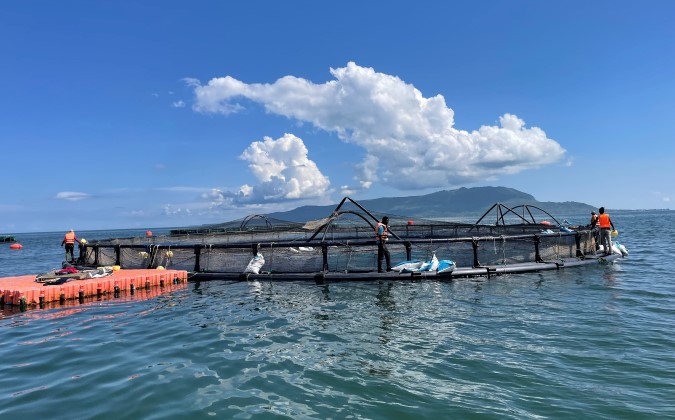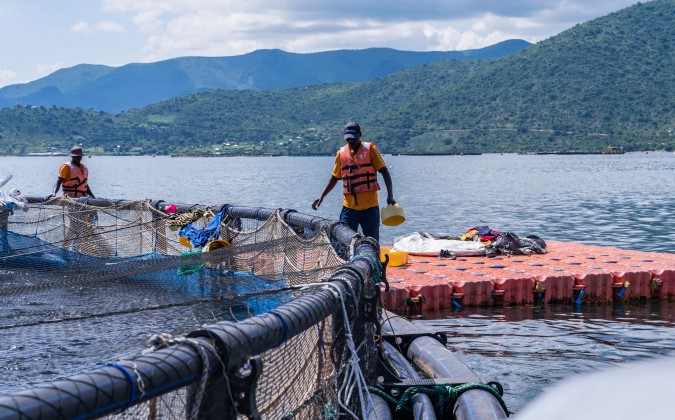
Bringing aquaculture into mission to boost sustainable livestock production in Sub-Saharan Africa
An interview with Ben North, technical director, Global Commercial Development, Aquaculture Health
Q: Tilapia farmers in Sub-Saharan Africa (SSA) are set to benefit from participation in the A.L.P.H.A. Plus initiative. Can you tell us a bit about the background and goals of the initiative?
BN: The first A.L.P.H.A. initiative, launched in 2017 in partnership with the Bill & Melinda Gates Foundation, helped to establish sustainable veterinary care in Uganda, Nigeria, Tanzania and Ethiopia over the course of 5 years. The achievements of the project were impressive, with more than 128 million animals treated, 91 innovative veterinary products made commercially available and a network of diagnostic laboratories opened. A.L.P.H.A. Plus will build on the success of the first initiative, expanding to more countries and livestock species, including tilapia.
Helping to support the scale-up and technification of livestock production in the region is a key objective for Zoetis, so it’s natural that PHARMAQ takes the lead on the aquaculture components of the initiative where we can contribute with our expertise in fish vaccines, diagnostics and health management, as well as our long experience from other aquaculture markets.
Q: What is known about the existing capacity for fish-health management, diagnostics and treatment methods in SSA, compared to other tilapia-producing regions?
BN: We’ve just started on A.L.P.H.A. Plus and are still getting to understand the lay of the land, but so far there seems to be a general need for capacity building with regard to fish-health management. It also seems that there are limited options for diagnostics services locally, and for PCR analyses. Some farmers have to send samples to labs in South Africa, Egypt or even further afield.
This lack of local services means that there is a long turnaround time on getting results, expensive logistics and probably a lot of paperwork, so it’s far from ideal. The results from such analyses usually come too late to be a useful decision-support tool for farmers. I expect there will be other diagnostics and fish-health services available locally, possibly through academic or governmental labs. Some of the bigger producers may also have developed in-house capabilities.
There is a wider range of fish services available in more established tilapia-farming countries such as Brazil, but the situation is still very different from salmon farming, where producers usually have the luxury of choosing from different labs that offer a comprehensive range of off-the-shelf analyses. Allowing easier disease diagnostics would significantly improve the sustainability of the fish production in SSA.
Q: Where do you think the “big wins” are likely to be?
BN: Firstly, gaining an understanding of what diseases are present in tilapia production systems will provide a very beneficial baseline for individual farming operations and the industry as a whole. Also, mapping gaps in competence and facilitating capacity building in fish farming and health management, in collaboration with academia and other partners, will be important to build a foundation for sustainable growth and production. Then it will be a case of trying to understand what the most effective method of prevention, treatment or control is.
I think that ultimately the large-scale tilapia producers in SSA will need to vaccinate their fish, as risk of infectious-disease outbreaks is almost inevitable as production volumes increase. The trend in the developed tilapia markets in Latin America is for more and more farmers to vaccinate their fish, as there are usually one or more Streptococci species present, including different serotypes of Streptococcus agalactiae. Viral diseases such as ISKNV (infectious spleen and kidney necrosis virus) and tilapia lake virus are also endemic in some of the developed tilapia markets in Latin America.
I would be surprised if we don’t find some of the usual suspects on tilapia farms in SSA, but as large-scale tilapia production is still quite new in some regions, it may also be that some of these diseases are not yet present. In this case, the big win will be optimizing fish-health management and implementing biosecurity strategies to prevent these diseases from entering the farms.
Q: Can you provide a bit more detail about what the aquaculture health components of the initiative are likely to entail?
BN: In essence we will be conducting a market assessment to understand the fish-health needs of tilapia farmers in SSA. We will start out by gathering baseline data and then want to conduct an epidemiological study, screening for the presence of different diseases. Knowledge of basic things such as rates and causes of mortality is key to understanding if we have relevant solutions to offer these markets.
It may be that we have relevant antigens in an already-licensed fish vaccine or a vaccine that is in the R&D pipeline. We can then assess whether these antigens are relevant for SSA and if we can make that product available in new markets. This will all take time, but the first step is to understand the disease situation and the fish-health needs, which we will do over the next 2 to 3 years.
Q: How many resources are being earmarked for the aquaculture aspects?
BN: In this planning phase we are still evaluating what resources we need to deliver our goals around aquaculture health, but the approach will be different compared to terrestrial livestock species. Zoetis has a broad portfolio of products and services for these other livestock species, and one of the key focus areas of the initiative there will be to make relevant products available to farmers in SSA. For tilapia, we are building our vaccine portfolio and are still at the market-assessment stage when it comes to relevant solutions for SSA. There is also a large component of the initiative that will be run by our colleagues from Zoetis’ Center of Excellence, which will be focused on rolling out digital platforms and conducting outcomes-based research.
I also see opportunities for us to contribute toward the training and capacity-building deliverables on the initiative as we’re lucky to have some of the best fish veterinarians and clinicians in the world working in the company. Even though aquaculture health is a relatively small part of A.L.P.H.A. Plus, there is a huge amount of enthusiasm for it, so one of the biggest challenges will be managing expectations in terms of how much we can commit to doing. I think though that by tapping into the expertise we have in the company and utilizing existing platforms such as our I-wise aquaculture customer portal, we can work smart and make an impact.
Q: There’s a social component to the initiative too, isn’t there?
BN: Yes, a high-level goal of the initiative is inclusive agricultural transformation that increases rural incomes, empowers women, better nourishes families and spurs economic growth. Increasing women’s empowerment in agriculture and equitable consumption of a safe, affordable, nutritious diet underpins this goal, and this is very relevant to the aquaculture work. In Kenya, for example, Victory Farms has made farmed tilapia an accessible source of protein that is sold through an advanced distribution network, where women make up around 80% of the people involved in the value chain. This offers a safe alternative to the traditional distribution networks of wild-caught tilapia where distributors who sell the fish in markets may be prone to exploitation.
More broadly, I feel that development agencies and donor organizations are recognizing the massive potential of aquaculture to improve livelihoods, increase food security and provide societal benefits. In addition to providing a source of healthy protein and jobs, the example in Kenya illustrates how aquaculture can provide widespread and profound benefits throughout the value chain.
Q: How many fish farms/farmers is the initiative hoping to engage with?
BN: We still need to figure this out during this planning phase, but we will initially concentrate on larger-scale tilapia producers, as these are the companies that will most likely be the first to need our products and services. We hope to be able to reach smaller producers by partnering with other organizations where our fish-health expertise may be beneficial on different capacity-building initiatives.
I’m also looking for opportunities for us to engage with veterinary schools and academic institutions in SSA where our fish-health experts may be able to contribute to the training of students. So, we should be able to engage with a range of different tilapia farmers, both directly and indirectly, over the next few years. The A.L.P.H.A. Plus initiative will provide resources and structure to help make a difference in a young and growing industry much sooner than we would otherwise have been able to, so I feel very positive about this and am excited to see what we can achieve in the coming years.







